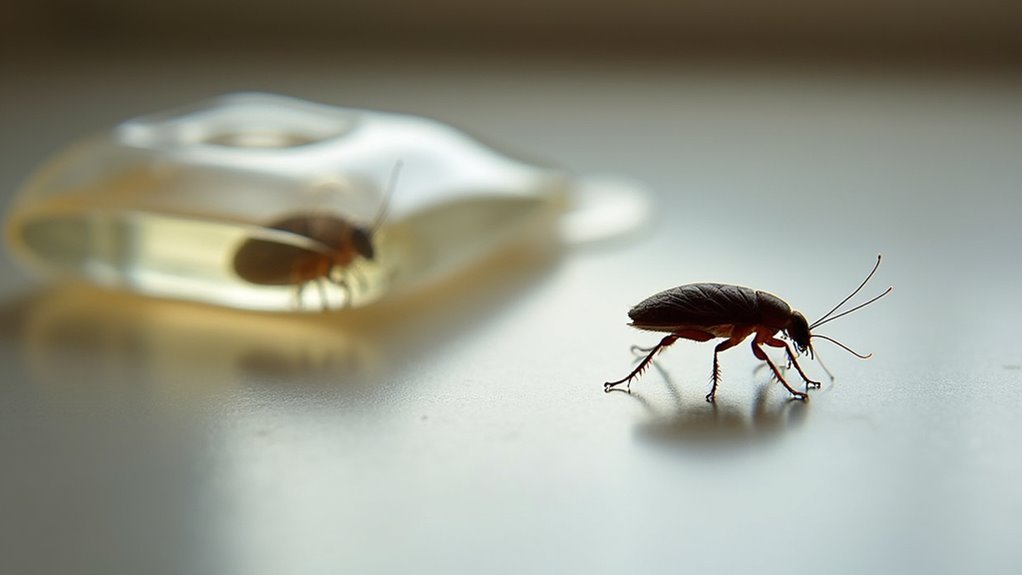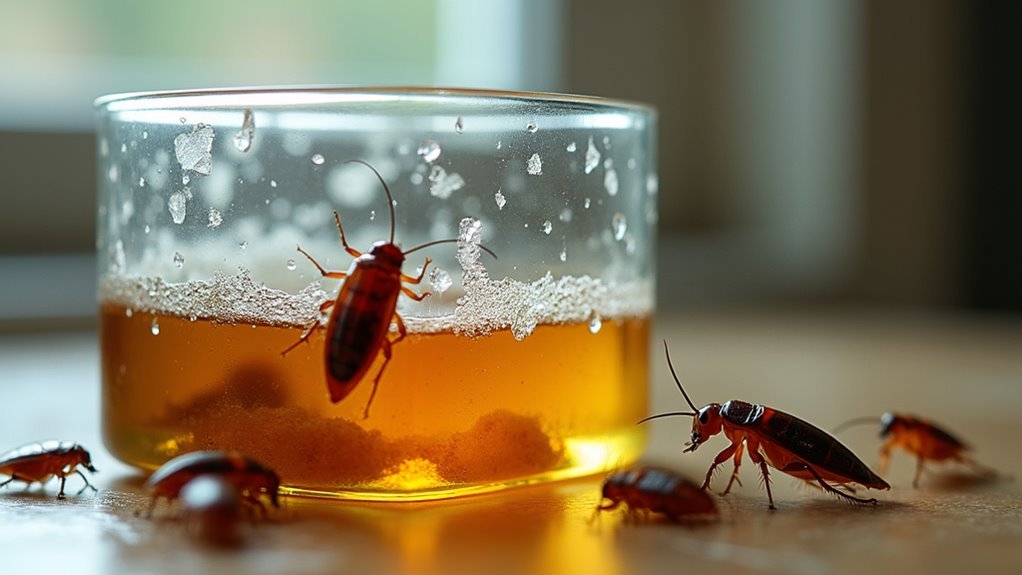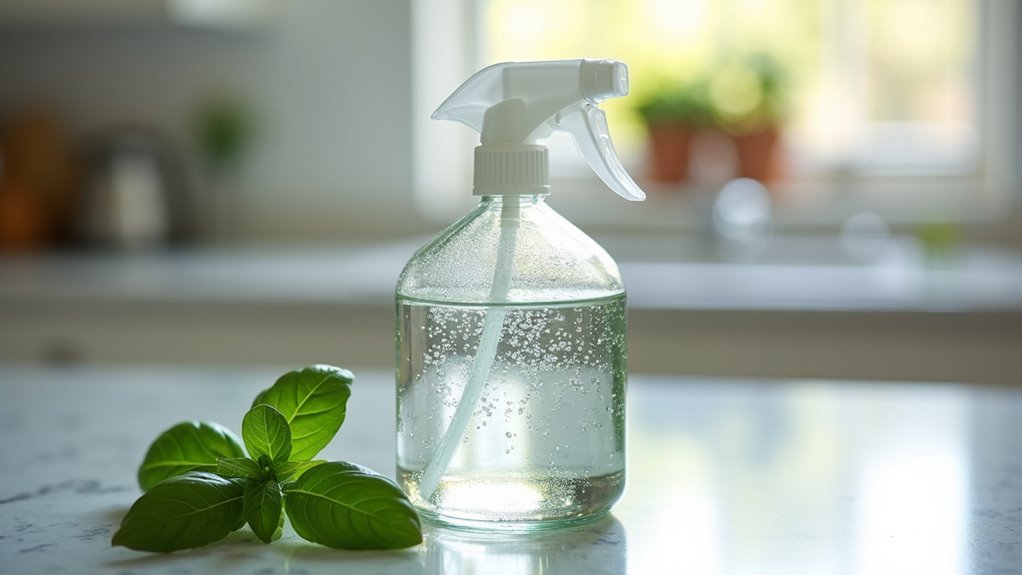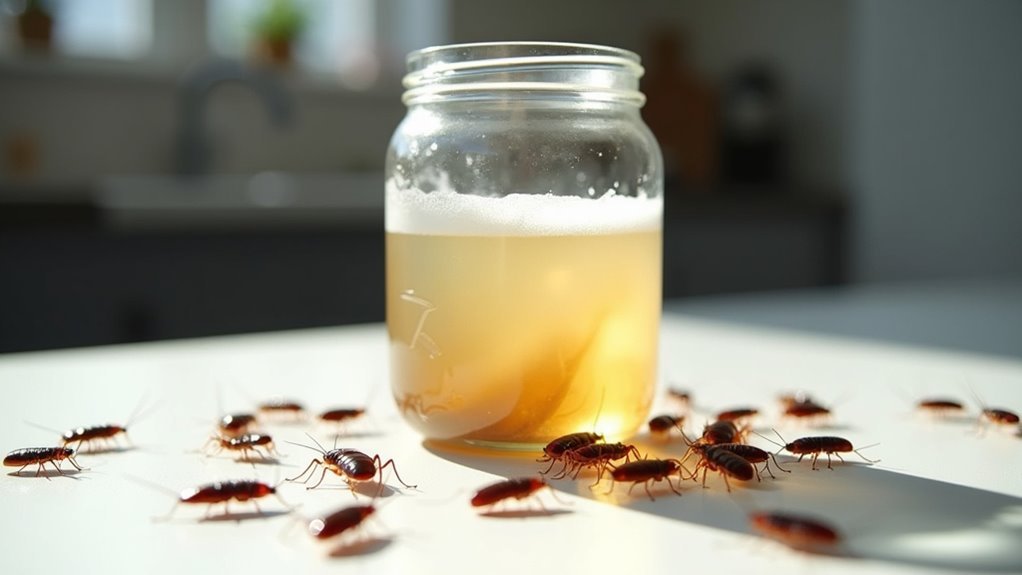Vinegar-soap traps eradicate roaches by attacking their navigation system and respiratory function simultaneously. The vinegar’s acidic odor masks pheromone trails cockroaches rely on for navigation while also attracting them to trap locations, mistaking it for decaying organic matter. Meanwhile, dish soap reduces water’s surface tension, allowing the solution to penetrate their exoskeleton and flood their spiracles, causing rapid suffocation. This dual-action approach disrupts their communication network while eliminating individual roaches effectively through targeted placement strategies.
Understanding How Cockroaches Navigate Using Scent Trails

Millions of cockroaches worldwide navigate through your home’s darkest corners by following invisible highways made of scent. These scent trails consist of pheromones that roaches leave behind, creating chemical roadmaps to food sources and safe pathways.
When you’re sleeping, cockroaches efficiently follow these familiar signals to locate sustenance and return to their nests without getting lost in complete darkness.
Understanding this navigation system reveals why traditional pest control methods often fail. Cockroaches don’t randomly wander—they’re following established routes.
Cockroaches follow predetermined chemical highways rather than wandering aimlessly, which explains why conventional extermination approaches consistently prove ineffective.
However, vinegar’s strong acidic odor masks these pheromone signals, making it an effective cockroach repellent. When you use vinegar to disrupt roach communication networks, you’re fundamentally erasing their GPS system.
This confusion prevents them from finding food and forces them to repel cockroaches from treated areas permanently.
The Science Behind Soap’s Surface Tension Properties
While vinegar disrupts cockroaches’ navigation systems, soap attacks their physiology through a completely different mechanism.
You’re fundamentally weaponizing water’s molecular properties when you add soap to your trap solution. Soap dramatically reduces surface tension, transforming water from droplets that roll off a cockroach’s waxy exoskeleton into a penetrating liquid that spreads everywhere.
This reduced surface tension allows the soapy water to infiltrate the cockroach’s spiracles—tiny breathing pores along their body. Once these respiratory openings become flooded and blocked, suffocation occurs rapidly. The soap creates an interfering film that prevents normal gas exchange, fundamentally drowning the insect in air.
When you combine vinegar’s attractive properties with soap’s lethal surface tension reduction, you create a highly effective trap that both lures and eliminates cockroaches efficiently.
How Vinegar Attracts Cockroaches to Trap Locations

You’ll find that vinegar’s acidic scent acts as a powerful attractant because cockroaches mistake it for decaying organic matter they naturally seek out.
When you place these traps strategically, the vinegar disrupts their sensory systems and draws them away from actual food sources toward your trap locations.
Your success depends on understanding how cockroaches respond to vinegar’s smell and positioning traps where this scent can effectively lure them in.
Vinegar’s Scent Properties
Three key mechanisms make vinegar’s scent properties particularly effective at drawing cockroaches into trap locations.
First, the strong smell of vinegar disrupts cockroaches’ delicate olfactory receptors, confusing their natural navigation systems. This disruption makes them more vulnerable to your DIY pest control efforts rather than helping them repel roaches as you might expect.
Second, cockroaches mistake vinegar’s pungent odor for potential food or water sources, drawing them directly toward your traps. This attraction turns vinegar into an effective cockroach killer when combined with soap.
Third, vinegar’s ability to mask other environmental scents creates a focused attraction point. The lingering acidic aroma continues working over time, maintaining its luring power and ensuring sustained effectiveness in your pest control strategy.
Roach Sensory Response
Understanding cockroaches’ sensory systems reveals why vinegar proves so effective at luring these pests into your traps. The roach sensory response to vinegar’s strong odor disrupts their natural navigation abilities, making them vulnerable to capture.
Acetic acid interferes with their sensory receptors, causing confusion that draws them toward trap locations rather than away from danger.
You’ll find that vinegar’s pungent aroma mimics food sources, triggering their investigation instincts. This deception works because cockroaches rely heavily on smell to locate meals and safe passages.
When you position vinegar-based traps strategically, you’re exploiting their sensory weaknesses. Among various cockroach control methods, this approach succeeds because it turns their survival mechanisms against them, creating an irresistible attraction that leads directly into your elimination strategy.
Trap Placement Strategy
Strategic placement maximizes your vinegar-soap traps’ effectiveness by positioning them where cockroaches naturally travel and congregate.
Your trap placement strategy should focus on kitchens and bathrooms, where roaches actively seek food and water sources. Place vinegar-soap traps near sinks, behind appliances, and along baseboards where these pests commonly hide.
Vinegar’s strong odor draws cockroaches directly to your trap locations while disrupting their established scent trails. This confusion encourages thorough exploration of treated areas, increasing contact with your lethal mixture.
Unlike harsh chemicals, this natural repellent approach provides effective pest control without toxic residues.
Position traps strategically in corners and against walls where roaches prefer traveling.
Regular monitoring of these cockroach control methods helps you assess population reduction and adjust placement for ideal results.
Creating the Perfect Vinegar-Soap Solution Ratio

You’ll need to get the mixture proportions just right to maximize your trap’s effectiveness against cockroaches.
The quality of ingredients you choose directly impacts how well the solution attracts and captures roaches in your home.
Testing different concentration levels helps you find the perfect balance that works best for your specific roach problem.
Optimal Mixture Proportions
When creating an effective vinegar-soap trap, the foundation lies in achieving the right balance of ingredients that’ll both repel and capture roaches.
The ideal mixture proportions for your vinegar-soap trap involve combining equal parts white vinegar and water in a 50/50 solution. You’ll want to add 1-2 teaspoons of dish soap to every cup of this vinegar-water mixture to maximize effectiveness.
This specific ratio guarantees the vinegar’s acidic nature disrupts cockroach scent trails while the soap reduces surface tension, causing roaches to sink upon contact.
To repel cockroaches even more effectively, you can enhance your trap by adding a few drops of essential oils like peppermint or tea tree.
Remember to refresh this mixture every few days to maintain its potency against unwanted pests.
Ingredient Quality Matters
Although many assume any vinegar and soap will suffice, selecting high-quality ingredients dramatically impacts your trap’s effectiveness against roaches. White vinegar’s superior acidity level attracts roaches more powerfully than apple cider vinegar, making it your best choice for this solution.
| Vinegar Type | Acidity Level | Roach Attraction |
|---|---|---|
| White Vinegar | 5-8% | Excellent |
| Apple Cider | 4-6% | Good |
| Rice Vinegar | 3-4% | Poor |
| Balsamic | 2-3% | Very Poor |
| Wine Vinegar | 3-5% | Fair |
Your dish soap choice matters equally. Dawn or similar concentrated formulas reduce surface tension effectively, ensuring roaches can’t escape once they contact the trap. Cheap, diluted soaps won’t suffocate roaches efficiently, compromising your entire solution’s performance.
Concentration Testing Methods
Finding your ideal vinegar-soap concentration requires systematic testing with different ratios to maximize trap effectiveness. Start with the standard 1:2 soap-to-vinegar ratio, then experiment with variations like 1:1 or 2:1 mixtures. Higher soap concentrations enhance stickiness, while maintaining around 50% vinegar concentration disrupts roaches’ sensory pathways effectively.
Test different combinations in separate roach traps and monitor capture rates over several days. You’ll want to adjust ratios based on your specific infestation level and environment. These DIY roach control methods require patience and observation.
Key testing strategies include:
- Document capture rates for each ratio over 48-72 hour periods
- Test multiple locations simultaneously with different concentrations
- Adjust formulations based on environmental factors like humidity and temperature
Refining your mixture through these control methods guarantees ideal long-term results.
Strategic Placement of Traps in High-Activity Areas
Since cockroaches follow predictable patterns when searching for food and shelter, you’ll achieve better results by placing your vinegar-soap traps in their high-traffic zones.
Focus on high-activity areas like behind appliances, under sinks, and dark corners where roaches frequently travel. Target entry points including cracks and crevices that serve as pathways for these pests.
Strategic trap placement in appliances’ shadows, sink undersides, and shadowy corners targets roaches at their most vulnerable travel routes.
Position traps near food sources such as garbage cans and pantry shelves to maximize attraction. This strategic trap placement rivals professional cockroach control service methods while using simple household ingredients.
Deploy multiple traps across different locations to cover wider areas during peak nighttime activity. Monitor your pest control methods regularly and relocate traps as roach movement patterns shift, ensuring consistent effectiveness throughout your home.
Why Dish Soap Immobilizes Cockroaches on Contact
When you use dish soap in your roach traps, it creates a sticky coating that immediately immobilizes cockroaches upon contact.
The soap solution blocks their spiracles, which are the tiny breathing pores they need for respiration.
This dual action of physical entrapment and respiratory disruption makes dish soap highly effective at quickly incapacitating roaches in your homemade traps.
Soap Blocks Breathing Pores
While vinegar acts as a deterrent, dish soap takes a more direct approach by targeting cockroaches’ respiratory system. When you mix dish soap with water, you’re creating a lethal coating that blocks spiracles—the tiny breathing pores cockroaches rely on for survival. This blockage effectively suffocates them upon contact.
The soap’s thick consistency helps it cling to the roach’s body, preventing escape and ensuring rapid immobilization.
Here’s how soap disrupts their breathing:
- Spiracle blockage – Soap creates an airtight seal over breathing openings
- Surface tension reduction – Allows deeper penetration into respiratory channels
- Viscous coating – Prevents cockroaches from cleaning themselves
Unlike vinegar alone, your vinegar-soap trap doesn’t just repel—it actively eliminates roaches. This combination makes it an incredibly effective addition to your pest control routine, delivering true kill roaches results.
Sticky Solution Traps Roaches
Beyond blocking breathing pores, dish soap creates a viscous trap that physically immobilizes cockroaches the moment they make contact. This sticky solution disrupts water’s surface tension, making escape impossible once roaches touch it.
You’ll find this mechanism particularly effective among roach control methods because it provides instant results.
When you mix soap with water and vinegar, you’re creating one of the most reliable home remedies for immediate pest elimination. The enhanced stickiness guarantees roaches can’t break free, allowing the solution to kill cockroaches through prolonged contact.
You can strategically place these traps in high-traffic roach areas for maximum effectiveness.
This direct-contact approach targets visible infestations immediately, helping you maintain a pest-free environment through proven immobilization techniques.
Comparing White Vinegar Vs Apple Cider Vinegar Effectiveness
Although both white vinegar and apple cider vinegar can deter cockroaches, white vinegar delivers superior results due to its higher acidity levels.
When you’re establishing a cleaning routine to repel cockroaches, white vinegar’s potent acidic properties disrupt their sensory receptors more effectively than apple cider vinegar. This natural roach deterrent creates stronger scent barriers that cockroaches actively avoid.
Here’s why white vinegar outperforms apple cider vinegar:
- Higher acidity disrupts cockroach navigation – White vinegar’s stronger acid content interferes with their ability to follow scent trails.
- Superior masking properties – The intense odor effectively covers existing pheromone markers left by other roaches.
- Better concentration ratios – A 50/50 white vinegar-water solution provides prime effectiveness without diluting potency.
Apple cider vinegar’s lower acidity makes it less suitable for serious infestations, limiting its effectiveness as a primary deterrent.
Adding Essential Oils to Enhance Trap Performance
When you incorporate essential oils into your vinegar-soap traps, you’ll create a powerhouse combination that greatly boosts capture rates. Adding peppermint or tea tree oil provides stronger scents that simultaneously attract roaches while disrupting their sensory receptors. These oils possess natural insecticidal properties that incapacitate roaches upon contact, preventing escape.
| Essential Oil | Benefits |
|---|---|
| Peppermint | Disrupts roach navigation while masking food odors |
| Tea tree | Strong insecticidal properties enhance trap potency |
| Eucalyptus | Creates dual-action: attracts initially, then repel roaches |
You’ll need just a few drops mixed into your vinegar-soap solution to create this potent lure. The combination effectively masks competing food odors while the oils’ properties guarantee captured roaches can’t escape. Refresh your traps regularly with new essential oil mixtures to maintain maximum effectiveness.
Monitoring and Replacing Traps for Maximum Results
Since trap effectiveness depends heavily on consistent maintenance, you’ll need to check your vinegar-soap traps every 2-3 days to confirm they’re working at peak performance.
Monitoring allows you to assess how many roaches you’re catching and determine when it’s time to replace the solution.
Replace your vinegar-soap mixture when it becomes cloudy or loses its pungent smell, as diminished vinegar potency reduces trap attractiveness.
You should also refresh traps after emptying captured roaches to maintain ideal luring power.
- Set up multiple traps near known roach hotspots to maximize coverage and effectiveness
- Count trapped roaches in each location to gauge infestation severity and activity patterns
- Relocate underperforming traps to different areas where roach traffic might be higher
This systematic approach guarantees your traps remain potent roach-catching tools.
Safety Considerations When Using Vinegar-Soap Mixtures
While vinegar-soap traps offer an effective pest control solution, you’ll need to take proper precautions to protect your family and pets from potential hazards.
These safety considerations begin with choosing biodegradable soap that’s non-toxic, ensuring the mixture won’t harm your household if accidentally encountered.
You should strategically place traps in high cockroach activity areas while keeping them completely out of reach of children and pets. This prevents accidental ingestion, which could cause stomach upset or other complications.
Always position traps behind appliances, under cabinets, or in other inaccessible locations where curious hands and paws can’t reach them.
Despite using safer ingredients, you’re still dealing with a pest control solution that requires responsible handling and placement for maximum effectiveness.
Limitations of DIY Traps Vs Professional Pest Control
Although vinegar-soap traps can catch individual roaches wandering into your kitchen, they won’t solve larger infestations that require extensive treatment strategies.
These DIY traps have significant limitations when you’re dealing with established colonies hiding throughout your home.
You’ll find yourself constantly maintaining and reapplying these homemade solutions, while professional pest control services target the root cause with advanced techniques.
Professionals understand cockroach behavior patterns that you might miss, allowing them to eliminate nests and disrupt reproductive cycles effectively.
Key limitations of DIY approaches include:
- Temporary relief only – traps don’t address breeding sites or eggs
- Limited reach – can’t access hidden colonies behind walls or appliances
- Reactive approach – catches visible roaches but misses the larger population
For severe infestations, thorough professional treatment provides lasting results.
Maintaining Long-Term Roach Prevention After Trapping
Once you’ve successfully trapped roaches using vinegar-soap solutions, your focus shifts to preventing their return. Effective home maintenance requires consistent effort to control future infestations.
Success with roach traps is only the beginning—consistent home maintenance and vigilant prevention efforts are essential for long-term pest control.
Clean surfaces regularly with vinegar and soap to eliminate food residues and scents that attract roaches back to your space.
Seal cracks and crevices in walls, floors, and around plumbing to block entry points. Maintain a dry environment by fixing leaks and using dehumidifiers, since cockroaches need moisture to survive.
Store food in airtight containers and dispose of garbage frequently to reduce accessible food sources.
Monitor high-traffic areas consistently and reapply vinegar-soap traps as needed. This long-term approach helps prevent future roach problems and maintains the success of your initial trapping efforts.
Frequently Asked Questions
Does Vinegar and Soap Kill Cockroaches?
Yes, you’ll find that vinegar and soap kill cockroaches effectively. When you mix equal parts, the soap suffocates them while vinegar attracts them. However, you’ll need additional methods for complete infestations.
How Fast Does Vinegar Get Rid of Roaches?
You’ll see roaches trapped within minutes of contact with vinegar-soap mixture, but it won’t eliminate entire populations quickly. You’ll need weeks of consistent application to notably reduce roach numbers throughout your home.
What Is the Most Effective Homemade Cockroach Killer?
You’ll find boric acid mixed with sugar creates the most effective homemade cockroach killer. The sugar attracts roaches while boric acid destroys their digestive system, providing superior results compared to other DIY solutions.
What Is the Best Method to Eradicate Cockroaches?
You’ll achieve best results by combining multiple approaches: seal entry points, eliminate food sources, use gel baits or boric acid, maintain cleanliness, and consider professional treatment for severe infestations requiring thorough eradication.
In Summary
You’ve learned how vinegar-soap traps disrupt cockroaches’ scent navigation while the soap’s surface tension guarantees they can’t escape. You’ll get best results by maintaining proper ratios, placing traps strategically, and replacing them regularly. Don’t forget you’re dealing with safety considerations and recognizing when DIY methods aren’t enough. You’ll need to combine these traps with thorough prevention strategies to keep your home roach-free long-term.





Leave a Reply